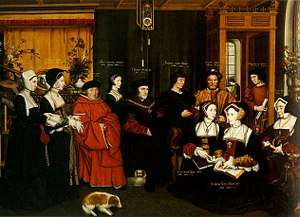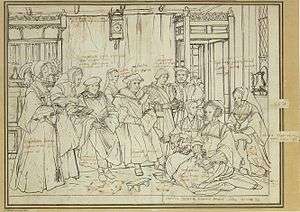Sir Thomas More and Family


Sir Thomas More and Family is a lost painting by Hans Holbein the Younger, painted circa 1527 and known from a number of surviving copies.
The original was destroyed in 1752 in a fire at Schloss Kremsier (Kroměříž Castle), the Moravian residence of Carl von Liechtenstein, archbishop of Olmutz.[1][2]
A study by Holbein for the painting survives in the Kunstmuseum Basel (Öffentliche Kunstsammlung Basel, Kupferstichkabinett Inv. 1662.31). The work is also preserved in a number of sixteenth-century versions by Rowland Lockey, including those in Nostell Priory and the National Portrait Gallery (formerly part of the Lenthall pictures).
Strong calls it "arguably the greatest and most innovative work of his English period" and "the earliest portrait conversation piece in English painting, at least a century ahead of its time" and asserts that "its destruction means we lost the greatest single visual artefact to epitomize the aims and ideals of the early Renaissance in England."[3]
NPG version
Sir Thomas More and Family in the National Portrait Gallery is a painting that was once part of the Lenthall pictures.[4]
The picture
Sir Thomas More and Family is one of two near life-size copies by Rowland Lockey[5] of an original by Holbein that was lost in a fire in the 18th century.[6] It is dated 1593; Holbein died in 1554.[7] It is oil on canvas and measures 89.5 inches (227 cm) by 120 inches (300 cm). It was probably commissioned by More's grandson, Thomas More II, to commemorate five generations of the family. The National Portrait Gallery lists[8] the sitters as:
- Elizabeth Dauncey (née More) (1506–1564), Second daughter of Sir Thomas More.
- Cecily Heron (née More) (born 1507), Youngest daughter of Sir Thomas More.
- Anne More (née Cresacre) (1511–1577), Wife of John More, son of Sir Thomas More.
- Cresacre More (1572–1649), Great-grandson and biographer of Sir Thomas More.
- Sir John More (circa 1451–1530), Judge; father of Sir Thomas More.
- John More (1510–1547), Son of Sir Thomas More.
- John More (1557–1599?), Eldest son of Thomas More II.
- Maria More (née Scrope) (1534–1607), Wife of Thomas More II.
- Sir Thomas More (1478–1535).
- Thomas More II (1531–1606), Grandson of Sir Thomas More.
- Margaret Roper (1505–1544), Daughter of Sir Thomas More.
The copy from the Lenthall collection has been described as “the most accomplished extant version”.[9]
The surviving drawing by Holbein confirms the general accuracy of picture.
Provenance
The painting had been at Gubbins in Hertfordshire. At some time it came into the possession of the Lenthall family, but how this happened is not known, although it may have been borrowed from the More family and never returned. In the 17th century, John Aubrey viewed it at the Besselsleigh home of Sir John Lenthall,[10] but by 1727 it was at Burford Priory.[11] It was discussed in detail by John Loveday who saw it in 1736. The painting was unsold in a small sale of the Lenthall pictures in 1808 but was offered again and sold in a major sale in 1833. It was subsequently owned by Walter Strickland, CW Dormer, Sir Hugh Lane, Viscount Lee, and EJ Horniman whose widow bequeathed it to the National Portrait Gallery where it remains.[12] It was the centre piece in the exhibition, The King's Good Servant, at the National Portrait Gallery in 1977.[13]
Nostell Priory version
The version at Nostell Priory is described as "the only faithful, same-size representation of the lost original" and is inscribed Rolandus Lockey/fecit a.d.., dated 1592.[14]
Other versions
A cabinet miniature version of this portrait c. 1594 with different details, also likely to be by Lockey, is in the Victoria and Albert Museum.[15][16]
Two further copies of the Holbein, at Old Chelsea Town Hall (formerly one of the Petre Pictures) and Hendred House, East Hendred, may be by Lockey, but are too damaged and over-painted for any certainty to be possible.[17]
Cultural influences
The painting is described in Hilary Mantel's Wolf Hall, a historical novel about the rise to power of Thomas Cromwell that won the 2009 Man Booker Prize:[18]
The favorite, Meg, sits at her father's feet with a book on her knee. Gathered loosely about the Lord Chancellor are his son John; his ward Anne Cresacre, who is John's wife; Margaret Giggs, who is also his ward; is aged father, Sir John More; his daughters Cicely and Elizabeth; Pattinson, with goggle eyes; and his wife, Alice, with lowered head and wearing a cross, at the edge of the picture. Master Holbein has grouped them under his gaze, filed them forever: as long as no moth consumes, no flame or mold or blight.
See also
References
- ↑ Guy, John (2009). A Daughter's Love: Thomas More and his Dearest Meg. Houghton Mifflin Harcourt. p.172.
- ↑ Strong, Roy (1990). Lost Treasures of Britain: Five Centuries of Creation and Destruction. London: Viking. ISBN 978-0-670-83383-2.
- ↑ Strong, Roy (1990). Lost Treasures of Britain: Five Centuries of Creation and Destruction. London: Viking. ISBN 978-0-670-83383-2.
- ↑ The English Counties Delineated, Volume 2, Thomas Moule, 1837
- ↑ Cooper, Tarnya (2008). A Guide to Tudor & Jacobean Portraits. National Portrait Gallery. p. 38.
- ↑ UK and Ireland Genealogy
- ↑ A biographical and critical dictionary of painters and engravers, Michael Bryan, page 337
- ↑ NPG catalogue entry
- ↑ Eade, Jane; Taylor, David (2015). "Sir Thomas More's Family". National Trust Historic Houses and Collections Annual. Apollo. p. 9.
- ↑ Hearn, Thomas; Aubrey, John (1813). Letters Written by Eminent Persons in the Seventeenth and Eighteenth Centuries: to which are Added, Hearne's Journeys to Reading, and to Whaddon Hall, the Seat of Browne Willis, Esq., and Lives of Eminent Men, by John Aubrey, Esq. Longman, Hurst, Rees, Orme, and Brown. p. 464.
- ↑ Tudor and Jacobean Portraits, Roy Strong, HMSO, 1969
- ↑ Lewis, 1998, p.32
- ↑ Lewis, 1998, p.32
- ↑ National Trust: Sir Thomas More and his Family (after Hans Holbein the Younger)
- ↑
- Strong, Roy (1969). The English Icon: Elizabethan and Jacobean Portraiture, London, Routledge & Kegan Paul p. 255.
- ↑ V&A Museum
- ↑ Lewis, Lesley (1998). The Thomas More Family Group Portraits After Holbein. Gracewing, Fowler Wright Books. p. 9. ISBN 0852444664.
- ↑ Mantel, Hilary (2010). Wolf Hall. Picador. p. 210.